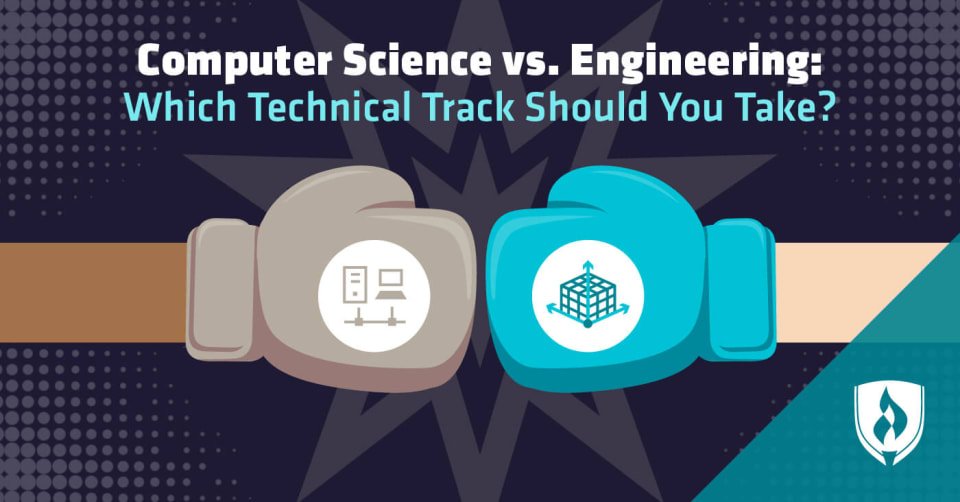Computer Science vs. Engineering: Which Technical Track Should You Take?
By Callie Malvik on 06/10/2019

You’ve heard all the hype about STEM (science, technology, engineering, mathematics) careers again and again, and you’re starting to consider them pretty seriously. Your analytical nature and problem-solving abilities have you thinking a career in technology or engineering may be the right move.
But you’re having trouble weighing computer science versus engineering. Your initial research suggests either route can lead to a bright future. So how can you determine which best aligns with your personal skills and interests?
We’re here to help with this side-by-side comparison of the two fields. Below you’ll find a helpful breakdown of the two fields—from education requirements to job titles to earning potential and more. Use this information to help you decide whether you’re destined for a career in either computer science or engineering. Wondering more about computer science and "is computer science right for me?" Read more here.
Computer science vs. engineering: The basics
You may have an idea of what each of these fields entail, but it’s important to have a fundamental understanding before choosing your path. Both fields require logical thinkers and methodical minds, and they both offer a huge array of career options. But there are still some differences that set them apart from each other.
Engineering as an industry tends to focus on building and designing things out of tactile materials. Engineers draft plans to build everything from helicopters to sewer systems, from medical devices to motherboards.
Computer scientists do somewhat similar work—but in the digital realm. They wield digital technology as well as computing languages to create, improve and build software and applications.
As you can see, the line between these two worlds is very thin, and there are a few professions that straddle the intersection completely. One career is that of a computer hardware engineer. Computer engineers normally have a degree in computer science, but perform the duties of an engineer. In this case, these engineers need a knowledge of how computers work in order to build circuit boards, processors and other hardware.
Other than this overlap, computer science primarily concerns itself with the landscape of the digital world, while engineering focuses on the landscape of the physical world. Let’s take a closer look at how these two fields differ in other ways.
Computer science vs. engineering: Common job titles
With a better understanding of the fundamental differences behind computer science and engineering, you’re probably curious about the careers in each field. Both industries offer a variety of positions that could potentially intrigue you.
We used job posting analysis software to examine job postings from the past year in each field. This data helped us identify the top five job titles in each industry.
Most common computer science positions1
Job duties:2
- Designs and customizes computer applications software
- Modifies existing software to optimize operational efficiency or correct errors
- Evaluates software requirements and user needs to determine software feasibility
Projected job growth (2016–2026): 24%2
Job duties:2
- Analyzes data processing problems to improve computer systems
- Develops and tests system design procedures
- Enhances system compatibility so information can be shared easily
Projected job growth (2016–2026): 9%2
Job duties:2
- Installs and supports an organization’s network system
- Examines website functions to ensure performance without interruption
- Performs data backups and disaster recovery operations
Projected job growth (2016–2026): 6%2
Job duties:2
- Installs software and firewalls on an organization’s computers
- Performs safety tests to determine any vulnerabilities in a network
- Creates disaster recovery plans for IT employees to follow in event of an emergency
Projected job growth (2016–2026): 28%2
Job duties:2
- Writes, designs and edits webpage content, or directs others producing content
- Identifies and corrects problems uncovered by testing or user feedback
- Backs up website files for immediate recovery in case of problems
Projected job growth (2016–2026): 15%2
Most common engineering positions3
Job duties:2
- Researches, develops and tests the manufacturing and installation of electrical systems
- Creates technical drawings or topographical maps to help guide installation and operations
- Directs efforts to ensure compliance with specification, codes and customer requirements
Projected job growth (2016–2026): 7%2
Job duties:2
- Designs, plans and develops materials used in a range of products
- Oversees a team of technologists, technicians, scientists and other engineers
- Calculates technical specifications, economic factors and impact of materials on the environment
Projected job growth (2016–2026): 2%2
Job duties:2
- Oversees installation, operation, maintenance and repair of mechanical equipment
- Reads and interprets blueprints, computer-generated reports or technical drawings
- Investigates equipment failures or issues to diagnose faulty operation and recommend solutions
Projected job growth (2016–2026): 9%2
Job duties:2
- Designs, develops and evaluates integrated systems for managing industrial production processes
- Estimates production budgets and cost-saving methods for management review
- Maps out the layout of equipment, materials and workspace to achieve maximum efficiency
Projected job growth (2016-2026): 10%2
Job duties:2
- Oversees the overall integration of technical activities in architecture or engineering projects
- Consults with various stakeholders to discuss project specifications or procedures
- Prepares and presents proposals, reports or findings to clients
Projected job growth (2016–2026): 11%2
Computer science vs. engineering: job outlook
For comparison, keep in mind that the average projected growth in employment for all occupations is 7% through 2026, according to the BLS.2
The BLS reports that computer science-related careers boast optimistic growth projections, with employment for positions like software applications developers projected to grow 31%.2 The average projected growth in employment for all positions in the field is at 13%.2 On the other hand, engineering jobs are expected to grow as fast as the average for all occupations, with an average projected employment growth of 7%.2
Judging by this category, it’s clear that computer science-related positions look to be growing at a faster rate. Some of this may be due to the maturity of the industries—in the grand scheme of things, computer science and technology positions are relatively new compared to the well-established engineering field, and it stands to reason maturing industries have additional room for growth.
Computer science vs. engineering: Education requirements
Another important factor to consider is the amount of education you’ll need to be eligible for these roles. Working in computer science or engineering requires an in-depth understanding of technical concepts. This means you’ll need to prove you’re qualified for the job by completing some formal education.
Our job posting analysis uncovered the preferred education levels indicated by employers hiring for computer science and engineering positions. The data revealed that 91% of employers required computer science candidates to have a Bachelor’s degree.1 Comparably, 89% of employers were looking to fill their engineering vacancies with Bachelor degree holders.2
As you can see, it’s clear that education is a critical component of finding employment in computer science or engineering. For those who are looking to enter the workforce as soon as possible, this area is essentially a push.
The choice is yours
In the question of computer science versus engineering, only you can decide which career path is right for you. The information above should help you weigh your options in order to determine which best aligns with your specific abilities and aspirations.
If you wish to leverage your logical mind in an industry that’s on the rise, it’s worth taking a closer look into computer science careers. Learn more about the many opportunities available in our article “What Can You Do With a Computer Science Degree?”
1Burning-Glass.com (analysis of 984,532 computer science job postings, Jan. 1, 2018 – Dec. 31, 2018).
2Bureau of Labor Statistics, U.S. Department of Labor, Occupational Outlook Handbook, [information accessed May 8, 2019] www.bls.gov/ooh/. Information represents national, averaged data for the occupations listed and includes workers at all levels of education and experience. Employment conditions in your area may vary.
3Burning-Glass.com (analysis of 653,201 engineering job postings, Jan. 1, 2018 – Dec. 31, 2018).
EDITOR’S NOTE: This article was originally published in 2017. It has since been updated to include information relevant to 2019.




